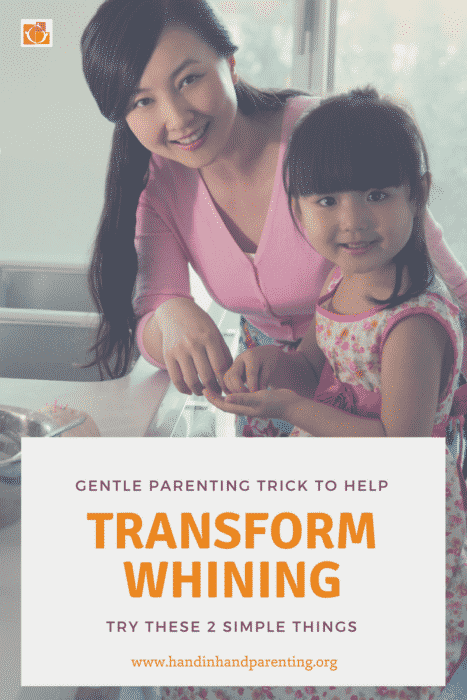![]() A Guest Post by Michelle Hartop
A Guest Post by Michelle Hartop
I picked up my seemingly happy seven-year-old from school one day, but by the time we got in the car to drive home, she was filled with frustration and tears. She was whining about what was for dinner and told me in no uncertain terms that she didn't want it and, “by the way,” I was “completely annoying to her.”
Twenty minutes later she's in the kitchen with me singing and helping prepare dinner.
What happened in those 20 minutes?
Dealing with Whining: How My Daughter Went From Angry To Happy in 20 Minutes
The first 10 minutes we were in the car, I listened to her whining and frustrations as I drove. Her tears flowed and her feet kicked the seat in front of her as she told me she didn't want to have stir-fry for dinner.
I figured the food wasn't really the issue, but that can be hard to see when just a few minutes ago she seemed fine, happy even. I knew she liked stir-fry and I had already taken into consideration her preference for noodles over rice!
It's Never About You! How to Keep Calm When Your Child Whines
Being flexible in my own thinking, and realizing where the limit was for me, I told her, “Well, we don't have to have stir-fry, but we do need to use the bok choy and pepper today so they don't go bad. Any ideas?”
With upset feelings still flooding her system, she wasn't flexible enough yet to consider that.
“Let's go to the grocery store!” she begged.
“No sweetie, we have good food at home to eat.”
“Can we stop at the library at least?”
“Not today, it's too far out of the way.”
She growled in frustration and kicked at the seat again.
Looking for the Reasons Behind the Upset Can Help
I reminded myself it was just hard feelings coming up. A long day at school can bring on frustration that needs to come out. I could have appeased her by meeting her demands and taking her to the library and the grocery store, but I've done that before and I know what happens. She settles for a little bit, happily distracted by getting what she wants in that moment, and then she starts on something else that she must have in order to feel better. (Not to mention I reach the end of my rope by catering to her and not taking care of my own needs for food and rest – Following that path never ends happily!)
So, I hold the limit: “Dinner at home, but I'm open to thinking of another way to prepare it.”
 More tears and frustration come pouring out. Even though I know it's not personal, I can feel my irritation growing nonetheless. I take some deep breaths and remind myself that this emotional storm will pass and I that can vent my irritation to my listening partner later.
More tears and frustration come pouring out. Even though I know it's not personal, I can feel my irritation growing nonetheless. I take some deep breaths and remind myself that this emotional storm will pass and I that can vent my irritation to my listening partner later.
Once we're home, and I'm not driving, I can offer more direct attention and affection. Of course, she pushes me away as I reach out to her, but I see a slight smile that lets me know she is ready for some playful connection.
We spend the next ten minutes playing games of chase with a few vigorous snuggles thrown in. This activity and laughter helps both of our moods improve and boosts our sense of connection. After about 10 minutes I let her know I need to get dinner started. Now that she's feeling lighter and more connected to me she follows me to the kitchen wanting to help.
And guess what?
Turns out stir-fry wasn't such an awful choice after all!
Get More Tools For Handling Outbursts and Upsets:
Try Listening with Empathy: How Listening to My Angry Son Helped Us Connect
Find out how play can clear tension: A Playful Response Helps With Whining and Pretend Pain

